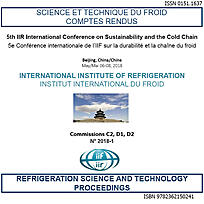
Résumé
With the development of the national economy and the continuous improvement of people’s requirements for food, the cold-chain logistics will enjoy more and more attention. The yields of fruits and vegetables in our country has been huge in recent years. To meet the trend of energy conservation and emission reduction and quantify the effect of cold chain on the environment, the life cycle assessment method was used to analyze the carbon footprint of fruits and vegetables cold-chain in the life cycle. The results show that the in each phase of cold chain, the carbon footprint of transportation accounts for a large proportion. As the storage time increases, the carbon footprint of the cold chain increases.The carbon footprint of the refrigerated transport phase and pre-refrigerated storage phase accounts for 50% -70% of the total cold chain. When the transport distance is short, the storage stage is dominant, and as the transport distance increases, the carbon footprint generated also increases.
Documents disponibles
Format PDF
Pages : 9
Disponible
Prix public
20 €
Prix membre*
Gratuit
* meilleur tarif applicable selon le type d'adhésion (voir le détail des avantages des adhésions individuelles et collectives)
Détails
- Titre original : Analysis of cold chain carbon footprint of fruits and vegetables in China
- Identifiant de la fiche : 30023339
- Langues : Anglais
- Source : 5th IIR International Conference on Sustainability and the Cold Chain. Proceedings: Beijing, Chine, 6-8 avril 2018
- Date d'édition : 06/04/2018
- DOI : http://dx.doi.org/10.18462/iir.iccc.2018.0001
Liens
Voir d'autres communications du même compte rendu (72)
Voir le compte rendu de la conférence
Indexation
-
Cold storage in India for small farmers - curre...
- Auteurs : TIWARI A., HARISCHANDER H., RANE M.
- Date : 2022
- Langues : Anglais
- Source : 2022 Purdue Conferences. 19th International Refrigeration and Air-Conditioning Conference at Purdue.
- Formats : PDF
Voir la fiche
-
UK cold stores – the road to net zero.
- Auteurs : COTTER D., MARQUES C., DAVIES G., LAGOEIRO H., FOSTER A., EVANS J.
- Date : 11/06/2024
- Langues : Anglais
- Source : 8th IIR International Conference on Sustainability and the Cold Chain. Proceedings: June 9-11 2024
- Formats : PDF
Voir la fiche
-
Huella de carbono del transporte refrigerado.
- Auteurs : RASINES L., SAN MIGUEL G., ARTÉS-HERNÁNDEZ F., AGUAYO E.
- Date : 04/2022
- Langues : Espagnol
- Source : XI Congreso Ibérico y IX Congreso Iberoamericano de Ciencias y Técnicas del Frío, CYTEF 2022.
- Formats : PDF
Voir la fiche
-
Development of cold chain in Russia.
- Auteurs : BELOZEROV G., TVOROGOVA A., ANDREEV S., et al.
- Date : 21/08/2011
- Langues : Anglais
- Source : Proceedings of the 23rd IIR International Congress of Refrigeration: Prague, Czech Republic, August 21-26, 2011. Overarching theme: Refrigeration for Sustainable Development.
- Formats : PDF
Voir la fiche
-
Energy and environmental assessment of strawber...
- Auteurs : HOANG H. M., MEROUANI A., DERENS-BERTHEAU E., SALEHY Y., DURET S., ANNIBAL S., MIREUR M., DELAHAYE A., MÉRENDET V.
- Date : 21/08/2023
- Langues : Anglais
- Source : Proceedings of the 26th IIR International Congress of Refrigeration: Paris , France, August 21-25, 2023.
- Formats : PDF
Voir la fiche
